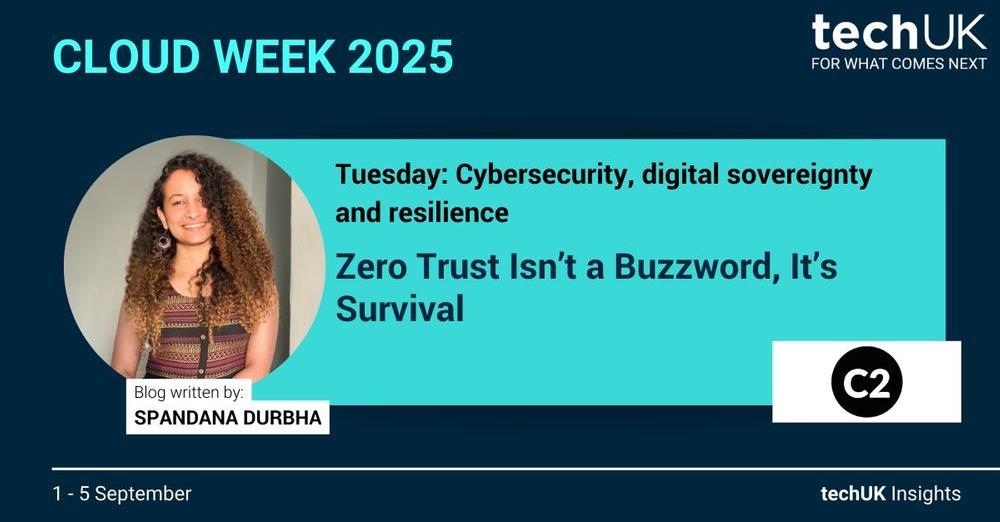Zero Trust Isn’t a Buzzword, It’s Survival

This blog was written by Spandana Durbha, Head of Security and Compliance, C2
In the digital world, cybersecurity is no longer a technical afterthought, it is a defining factor in organisational survival. The stakes have never been higher. Threat actors are sophisticated, borders are blurred, and dependency on complex digital ecosystems leaves little margin for error.
True strength lies not only in preventing attacks, but in ensuring resilience when they happen, and in maintaining sovereignty over the data and systems that underpin every modern enterprise.
Zero Trust Isn’t a Buzzword, It’s Survival
The old perimeter model is obsolete. Hackers no longer approach through the front door, they exploit the weakest link, whether that is an employee’s inbox, a misconfigured cloud bucket, or a compromised vendor. This is why Zero Trust has shifted from an industry trend to a strategic imperative. Never trust, always verify. It is not paranoia if the threats are real.
Google’s BeyondCorp model is a leading example of Zero Trust in action, removing VPNs and shifting security checks to the identity and device level (BeyondCorp).
By contrast, many organisations fail when they treat Zero Trust as a marketing label rather than a philosophy. Secureworks highlights cases where companies attempted a “Zero Trust rollout” without enforcing multi-factor authentication or device posture checks, leaving gaping holes that attackers happily walked through (Secureworks).
Encryption and Keys: The Locks on Your Digital Kingdom
Unencrypted data is an opportunity waiting to be seized. Strong encryption, paired with disciplined key management, ensures that even if data is stolen, it remains useless. But poor governance of keys undermines everything. In 2019, an improperly secured AWS key exposed personal information of more than 100 million Capital One customers, an incident that underlined how one small weakness can nullify an otherwise strong security posture.
Compliance ≠ Security
GDPR, NIS2, CCPA, the alphabet soup of regulation is not optional. Yet compliance is not the same as security. It represents the baseline, not the finish line. Organisations must approach compliance as a catalyst for stronger governance and customer trust, not as a checklist exercise. A compliant business that is insecure is still vulnerable, and attackers are indifferent to paperwork.
Digital Sovereignty: Taking Back Control
Sovereignty asks the hard questions: where is your data stored, who owns it, and who can demand access? These are mission-critical issues, not legal footnotes. Europe’s ongoing push for cloud sovereignty illustrates the risks: reliance on hyperscalers governed by foreign laws, like the US Cloud Act, exposes sensitive data to external control (TechRadar).
In contrast, Australia’s decision to build a locally owned and certified “Digital Fort Knox” for government and critical infrastructure data shows what sovereignty in practice looks like (The Australian)
From Detection to Recovery: Closing the Loop
Breaches are inevitable. The decisive factor is how quickly an organisation can detect, contain, and recover. Real-time observability and rehearsed recovery strategies are not operational luxuries, they are strategic safeguards.
The 2017 NotPetya attack on Maersk is a striking example. The shipping giant was effectively paralysed worldwide, with 4,000 servers and 45,000 PCs wiped in hours. Recovery was only possible because one domain controller in Ghana happened to be offline during the attack, allowing the company to rebuild. It cost Maersk hundreds of millions of dollars, but it also demonstrated the importance of backup strategy and recovery capability at scale.
The Weakest Link: Supply Chains
An organisation is only as strong as the ecosystem it depends on. Supply chains, sprawling and interconnected, present one of the most exploited vulnerabilities. Attackers target the overlooked contractor, the under-secured vendor, or the forgotten integration. Supply chain resilience requires robust due diligence, continuous monitoring, and the recognition that third-party risk is enterprise risk.
Final Word
Cybersecurity, digital sovereignty, and resilience are no longer siloed concerns of the IT department, they are board-level imperatives. The organisations that succeed will be those that embed Zero Trust into their DNA, assert sovereignty over their critical assets, and build resilience as a core capability rather than an afterthought.
The question is not whether an attack will come, but whether your organisation is prepared to withstand it, recover swiftly, and emerge stronger. In an era defined by digital dependence, resilience is not simply protection, it is competitive advantage.
For more information please contact:






